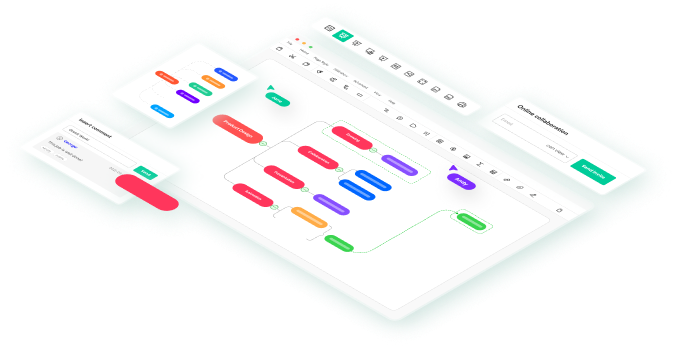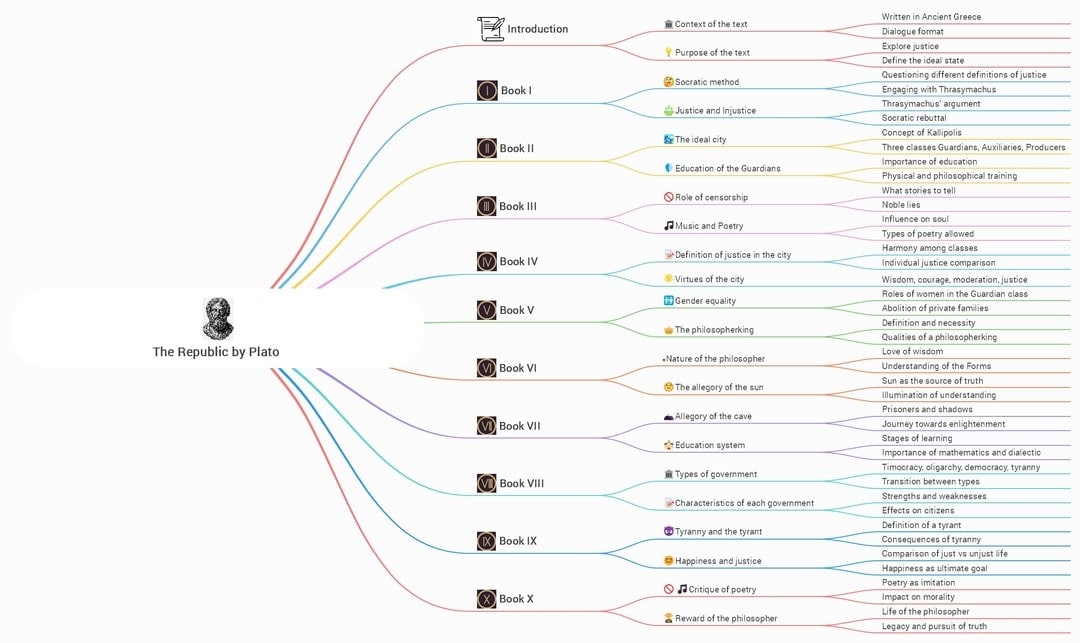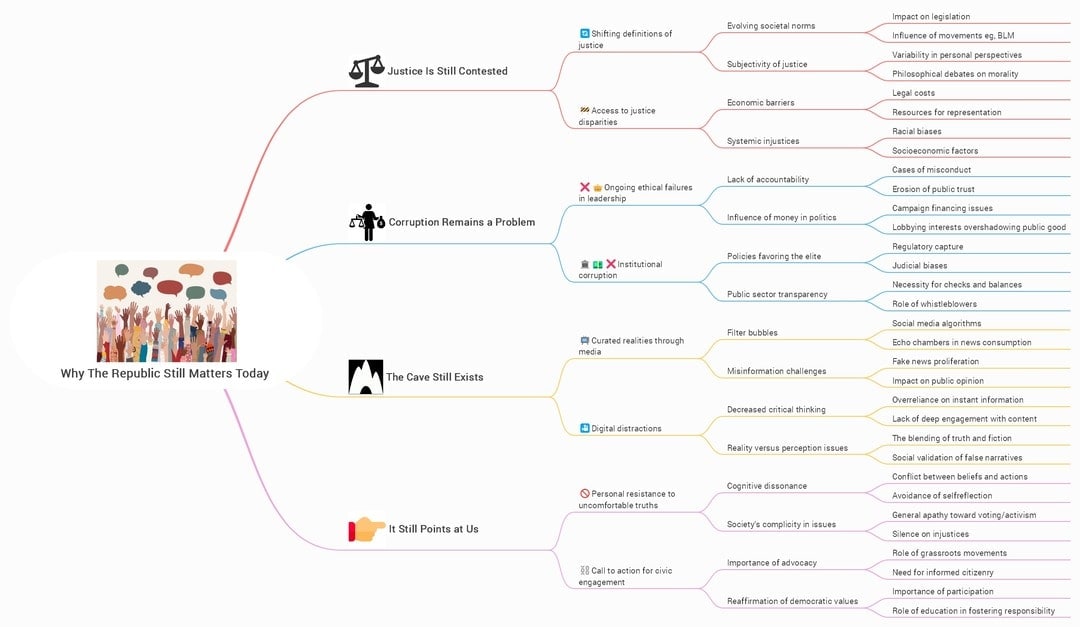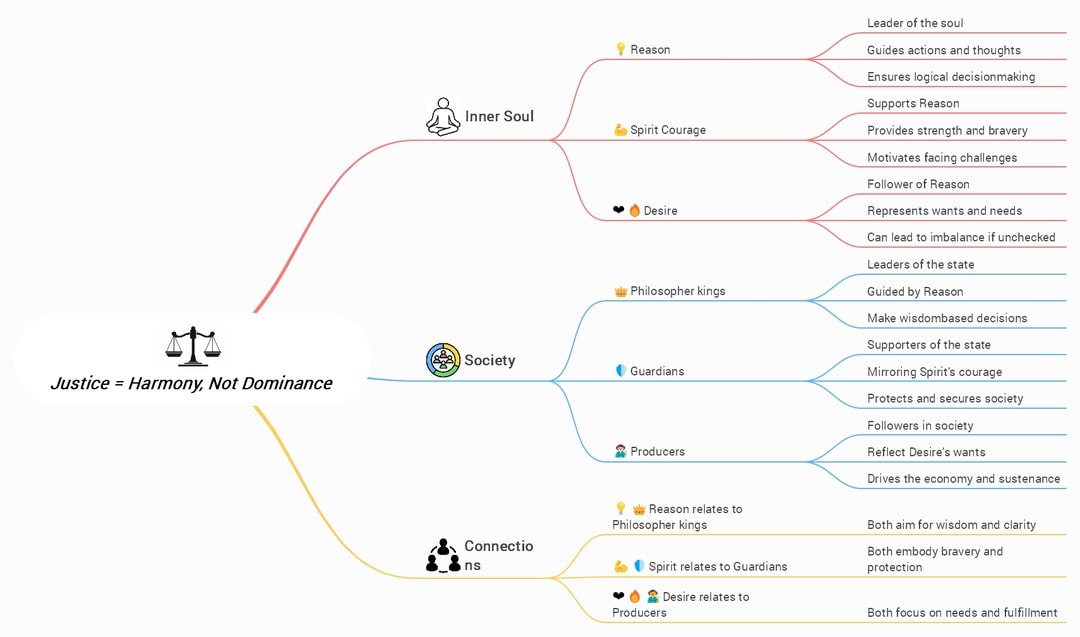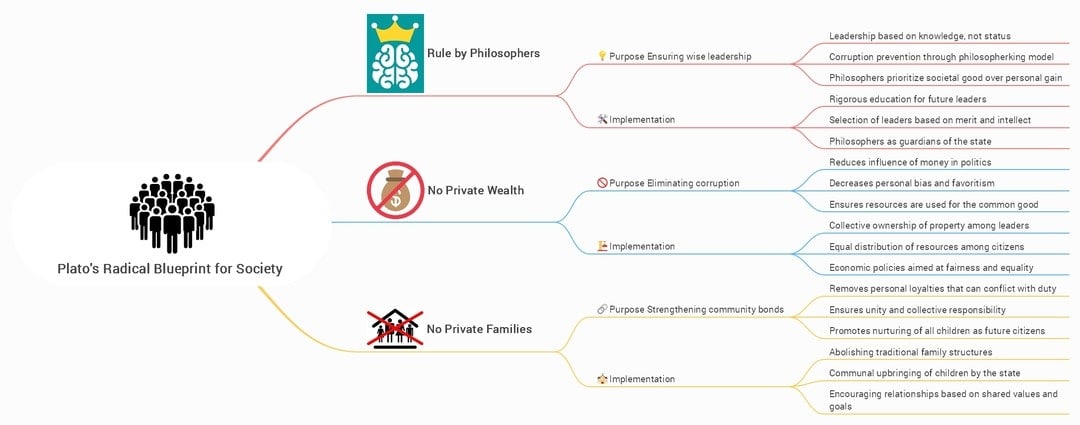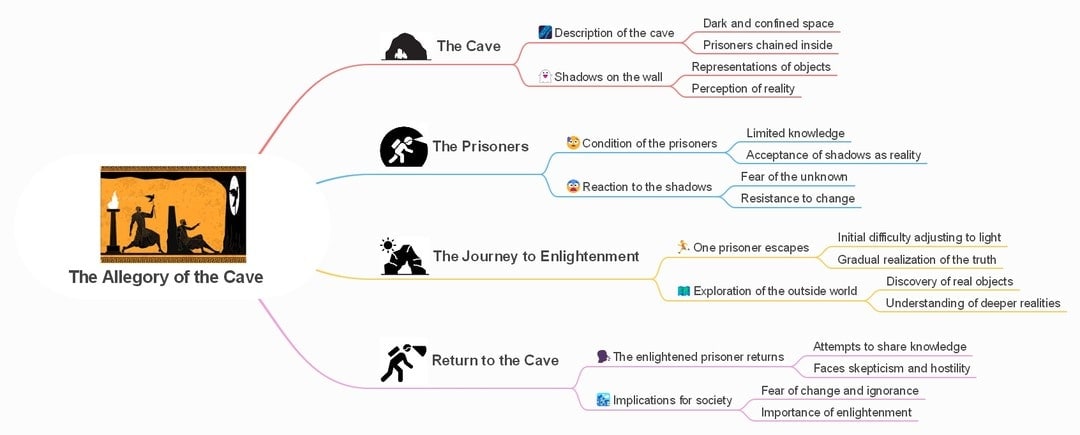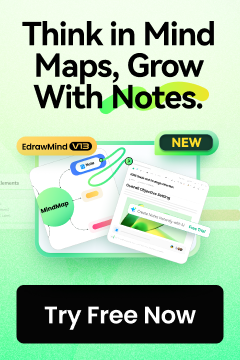Some books fade after a few centuries. The Republic hasn't, even after millennia. What surprised me was how uncomfortably familiar the problems sounded. Plato was writing about justice, leadership, and illusion long before those words filled debate stages and news feeds.
You won't always agree with where his arguments lead. But that's the point. He forces you to sit in discomfort. And by the end, you realize he's not trying to fix the world, he's trying to get you to look at it differently.
This write-up helps you follow that shift. I'll walk through the structure, spotlight three of its biggest ideas using simple mind maps. If you're curious about why The Republic is still taught and debated, this is your guide.
In this article
What Is The Republic
Around 380-375 BCE, long before the advent of constitutions or political theory classes, Plato laid out a comprehensive model of justice and government in his book, The Republic.
Plato structured it as a dialogue among thinkers, led by Socrates, making it more personal and less preachy. He talks through justice, power, education, and reality with others who push back or challenge him.
What Makes It Different
It doesn't give solutions upfront. The reader walks through disagreements, false starts, and discoveries.
There are 10 distinct parts. But they don't work in isolation; they stack, each supporting the next in a single argument.
Despite its age, the format keeps it alive. The format invites you into the thinking process, not just the conclusions.
Why It Still Hits Hard Today
Justice Is Still Contested Ground
Plato didn't provide a single definition. He exposed the fragility of the entire idea. Even now, "justice" means different things depending on your status, your side, or your story.
Corruption Isn't a New Problem
He stripped rulers of property and family ties to avoid personal agendas. Today, we continue to face the same issues with ethics boards, term limits, and transparency laws, and still fall short.
The Cave Never Closed
Most people still live in curated realities. Think of Snapchat, Virtual Reality. The screens changed, but the psychology remained the same. We still resist what doesn't match our version of the world. That was his point.
It Still Points at Us
It's not just a critique of rulers. It raises questions about how much we truly value truth, fairness, or self-reflection. That discomfort is why the book remains relevant.
3 Big Ideas
1. Justice = Harmony, Not Dominance
The Challenge Begins with Power
In Book I, Thrasymachus drops a sharp claim: "Justice is the advantage of the stronger." It's not a subtle statement but power politics, raw and unapologetic. The strong set the rules, and whatever benefits them gets labeled "just."
Socrates Doesn't Buy It
Instead of debating definitions, Socrates redirects the whole conversation. He shifts the focus to internal order instead of external power. For him, justice isn't something enforced, but something structured. He treats the human soul like a three-part system:
- Reason should lead
- Spirit (our drive, courage, ambition) supports
- Desire (our cravings and wants) must follow
When this inner hierarchy is intact, a person is just because they're stable, in control, and not ruled by impulse.
Society as a Scaled-Up Soul
Plato scales this model to the state itself:
- Philosopher-kings represent reason
- Guardians (soldiers) embody the spirit
- Producers (workers and merchants) express desire
Each group has its role. No one tries to dominate or cross into another group's role. Justice, in this sense, isn't a fight for dominance; it's everyone doing their job, and only their job, in sync.
Why This Still Cuts Deep
This idea flips modern assumptions. Today, we often associate justice with rights, protest, or the pursuit of fairness.
Plato goes deeper. He says justice is about internal structure, not just external outcomes. It's worth asking: does your life feel just because you're right, or because it's in order?
On a broader level: Do today's systems reward wisdom? Or strength? Or wealth?
2. Plato's Radical Blueprint for Society
He Doesn't Trust Democracy
Plato lived through the failures of Athenian democracy, executions, mob rule, and political chaos. So when he imagines a better state, he doesn't just tweak the system. He builds a new one from scratch.
Three Striking Rules
Plato lays out bold proposals for his ideal republic:
- Philosophers must rule: Only those who understand the truth and aren't swayed by public opinion should lead, rule by the informed, not the popular.
- No private wealth for rulers: Guardians and philosopher-kings can't own property or hold private assets. That way, their decisions stay focused on the good of the whole.
- No private families: Children are raised collectively. No one knows whose child is whose, removing bias, favoritism, and inheritance-driven inequality.
What He's Aiming For
He's not trying to create a utopia of happiness. He's aiming for purity of structure, where personal interests can't twist power.
Hard Questions Still Worth Asking
Even if the model doesn't fit modern life, Plato's logic exposes fundamental weaknesses in modern systems:
- Can power ever be free of personal gain?
- Is equality even possible when family and wealth decide opportunity?
- Would you trust a ruler with no personal stake, because they own nothing and have no family to favor?
Plato isn't offering a roadmap. He's daring you to rethink what a "fair" system really looks like.
3. The Allegory of the Cave: Seeing vs. Believing
The Setup (Book VII)
Imagine people chained in a dark cave, facing a wall. Behind them, a fire casts shadows of puppets. For them, those shadows are reality.
One prisoner escapes. Outside the cave, he's blinded at first. But slowly, he sees the real world, sunlight, color, and truth. When he returns to the cave to explain, no one believes him. They mock him. Shadows are all they know.
What It Means
Plato's point is brutal: Most people don't see the truth. They see what's easy to see, images, reflections, filtered inputs. Truth takes effort. And even when someone finds it, they often can't share it without being rejected.
What It Looks Like Today
You aren't in a cave. You have a feed. News algorithms, curated content, and partisan narratives all feed shadows. Comforting, familiar, unexamined.
Waking up? That's painful.
It means questioning assumptions you've held for years, maybe your whole life. It means being okay with discomfort and sometimes isolation.
Why It Matters
The allegory doesn't just explain perception. It warns against comfort and denial. The truth is out there, but if you're not willing to turn around, step out, and adjust your eyes, you'll never see it. Worse: you'll mock those who do.
Bonus: Pro Tips to Use EdrawMind to Visualize The Republic
1. Build the Core Map with Book-Based Branches
Create a central node labeled The Republic by Plato.
Add 10 main branches for each book (Book I to Book X).
Under each branch, list key themes, events, characters, and arguments specific to that book.
It keeps the entire dialogue organized without losing sequence or depth.
2. Use Color Codes to Group Themes
Assign color labels for recurring themes:
- Justice (blue)
- Education (green)
- Politics & Power (red)
- Reality/Truth (orange)
Apply these colors to nodes, allowing you to trace how each concept develops across the books.
It helps you track long threads, like how justice is shaped from Book I through Book IV and beyond.
3. Highlight Core Analogies and Metaphors Visually
Use icon markers or special symbols for analogies like:
- The Ship of State
- The Divided Line
- The Allegory of the Cave
Group them in a separate node called Plato's Analogies and link them back to the relevant book.
Great for presentations or quick reference, especially when comparing abstract concepts.
4. Convert Your Map into an Outline and Presentation Instantly
Once your mind map is ready, use EdrawMind's built-in tools:
- Click "Outline Mode" to switch the visual map into a clean, hierarchical text outline, ideal for writing papers or building notes.
- Use "Presentation Mode" to turn each branch into a slide. You can walk through the argument book-by-book or theme-by-theme in front of a class or study group.
It saves time and lets you reuse the same map across formats, eliminating the need to retype anything.
5. Add AI-Powered Notes or Auto-Summaries
Use EdrawMind's AI Assistant to auto-summarize long sections from each book into one-click notes.
You can also generate possible discussion questions from a node, perfect for study or teaching sessions.
It boosts comprehension if you're working through The Republic for the first time or revisiting it with fresh eyes.
Bonus Tip: Save your mind map to the cloud so you can access it on any device, including Mac, Windows, iOS, or Android. Whether you're in class, prepping a talk, or studying solo, your complete breakdown of The Republic stays one tap away.



